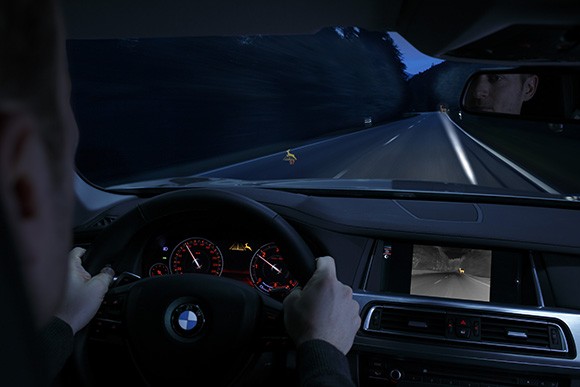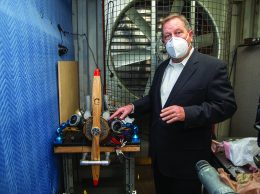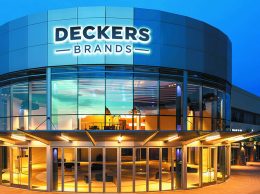Autoliv’s Goleta operation shines light on safety
IN THIS ARTICLE
- Latest news Topic
- Erika Martin Author
By Erika Martin Friday, January 23rd, 2015

The night-vision system produced by Autoliv in Goleta highlighted in BMW promotional materials. The automakers cars alert drivers of nearby pedestrians and animals in four ways: an infrared display, the intstrument panel, the heads-up display and a spotlight. (Photo courtesy Autoliv)
It happens to the best of us: You’re driving at night, eyes diligently on the road, when a pedestrian suddenly appears in your vehicle’s path.
It’s not the kind of adrenaline rush consumers seek from their cars, and Swedish company Autoliv is working from its Goleta facilities to reduce these hazardous situations. The publicly traded maker of auto safety products is harnessing the South Coast’s expertise in infrared technology to produce night-vision systems that are available in new Mercedes-Benz, Audi, BMW and Rolls-Royce models.
The design uses a thermal imaging sensor — also made in Goleta by FLIR Systems — to give drivers an infrared view of their surroundings and alert them to pedestrians or animals they are in danger of hitting. It also provides an image that cuts through dangerous conditions such as smoke and fog.
While the exact setup differs across the various makes and models, the system uses the center console to display an infrared view of the vehicle’s surroundings that highlights subjects in its path and will also alert the driver via the instrument panel beneath the steering wheel, and in some models the head-up display. Outside the U.S., the vehicles also come equipped with a dynamic spotlight below each headlight that highlights pedestrians, yet is undetectable to them. Current American regulations prohibit the technology.
Stuart Klapper, managing director of Autoliv Night Vision, said this is due to outdated legislation and the company has met with officials in Washington to discuss updating the policy.
“The regulations for the U.S. were developed in 1968, and there are so many different advances in lighting technology, like laser headlights, that the government will have to change the way lighting regulations are written today,” Klapper said. “This is technology that saves peoples lives.”
Klapper joined Autoliv’s Goleta team eight years ago, but his work in night vision extends back to 1978, when he began his career at Hughes Aircraft and led the development of the first imaging pyroelectric sensors. He went on to install the first automotive night vision system on the 2000 Cadillac Deville at Texas Instruments and co-found Raytheon’s commercial infrared division.
He now heads the 50-employee Goleta operation, which produced 100,000 of the systems last year, up from 60,000 in 2013. That makes Autoliv the largest maker of infrared cameras in the U.S. by volume, Klapper said. The company expects to push production up to 300,000 units this year.
“The reason why we’re doing night vision technology is because 69 percent of all pedestrian fatalities do occur at night, and there’s a four times greater risk that you’ll hit somebody at nighttime, even though really only a quarter of the driving occurs at night,” Klapper said. “And 30 percent of pedestrians that you may hit will end up with a permanent medical impairment. The whole accident can be a life-changing legal and emotional event.”
The systems are put together by just five employees on a company-designed production line that analyzes the product at each step and will halt the process if it finds an error. The camera itself is situated at the front of the car — stashed in an Audi’s signature rings, for example — and is immediately disabled when detached from the car.
Klapper said its largest markets so far have been the U.S., China and Germany, which each make up a quarter of the company’s sales. He expects other countries to catch on once the technology becomes cheaper to produce and feasible for lower-priced cars.
“Our mission is to ultimately bring it down to a point where you can put this on any vehicle,” he said. “Today, it’s mostly on luxury vehicles, but we’re working now with some [original equipment manufacturers] that are mid-level that will soon introduce our system as well.”
The company bought a BMW X5 and was able to add its dynamic spotlight, which led to the realization that subjects are oblivious they’re in limelight. The streets of densely populated Isla Vista and dimly lit Santa Barbara gave Klapper’s team an ideal testing environment to fine-tune the range and sensitivity of the infrared sensor, he said.
“When I’ve been driving this car around Santa Barbara I get a spotlight alert and I think, ‘There’s nobody out there.’ Then, boom — I can’t believe it, there’s a person right there,” Klapper said. “It makes me think, how many times do I drive at night without the system and not realize there’s actually a person on or near the road that I’m close to hitting and I have no clue?”
But if you’re driving in an area with high pedestrian traffic such as Manhattan, the system is programmed to not cry wolf. “If they’re off the road but will potentially cross, we pay attention to what that pedestrian is doing,” Klapper said. “If they’re standing still or moving away from the path of the vehicle, we won’t prove the alert because nobody wants to keep getting alerts all the time,. But if a pedestrian looks like they’re headed toward the path of the vehicle, then we provide the alert to the driver.”
Autoliv was founded in 1953 by brothers Stig and Lennart Lindblad. It teamed with Volvo to create the first safety belt in 1956 and has grown to become the world’s largest supplier of airbags and seat belts, with 50,000 employees in 80 facilities across 29 countries.
Though the company exclusively produces automobile safety products, it has developed many technologies that provide consumers preventative as well as reactive safety. This includes features such as high beams that automatically dim when another car is near or a display of open escape routes in case of emergency.
“There are a lot of automotive parts suppliers that build lots of things: engines, controllers, wheels, whatever. We’re just about safety. That’s what our heritage and our company is all about,” Klapper said. “Every day when people at Autoliv get up and go to work, they feel good that they’re actually saving lives.”
The company is also teaming with Mercedes-Benz to supply sensor technologies for its F 015 autonomous concept car. Klapper said the industry as a whole is ultimately headed to a future in which drivers rely on radar more than their own capacities.
“You might say that’s dangerous, but in reality our sensors are much faster and better at actually seeing what’s out there than we are as humans,” he said. “As humans, we react sometimes slowly, sometimes we’re distracted listening to music or talking on the phone. The car is not going to do all those things. It’s just going to be looking at the road, so it’s really a much better solution for avoiding accidents.”
• Correction, Jan 23. at 12:31 p.m.: A previous version of this article stated that Autoliv’s system uses a thermal imaging camera from FLIR Systems. Autoliv uses a sensor from FLIR, but builds the cameras in-house.










